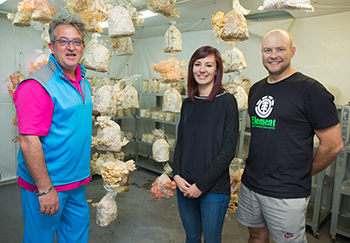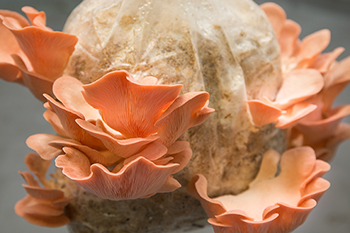
From the UFS Department of Microbial Biochemical and
Food Biotechnology are, from left: Prof Bennie Viljoen,
researcher, MSc student Christie van der Berg,
and PhD student Christopher Rothman
Photo: Anja Aucamp
Mushrooms have so many medicinal applications that humans have a substance in hand to promote long healthy lives. And it is not only humans who benefit from these macrofungi growing mostly in dark spaces.
“The substrate applied for growing the mushrooms can be used as animal fodder. Keeping all the medicinal values intact, these are transferred to feed goats as a supplement to their daily diet,” said Prof Bennie Viljoen, researcher in the Department of Microbial, Biochemical and Food Biotechnology at the UFS.
Curiosity and a humble start
“The entire mushroom project started two years ago as a sideline of curiosity to grow edible gourmet mushrooms for my own consumption. I was also intrigued by a friend who ate these mushrooms in their dried form to support his immune system, claiming he never gets sick. The sideline quickly changed when we discovered the interesting world of mushrooms and postgraduate students became involved.
“Since these humble beginnings we have rapidly expanded with the financial help of the Technology Transfer Office to a small enterprise with zero waste,” said Prof Viljoen. The research group also has many collaborators in the industry with full support from a nutraceutical company, an animal feed company and a mushroom growers’ association.
Prof Viljoen and his team’s mushroom research has various aspects.
Growing the tastiest edible mushrooms possible
“We are growing gourmet mushrooms on agricultural waste under controlled environmental conditions to achieve the tastiest edible mushrooms possible. This group of mushrooms is comprised of the King, Pink, Golden, Grey, Blue and Brown Oysters. Other than the research results we have obtained, this part is mainly governed by the postgraduate students running it as a business with the intention to share in the profit from excess mushrooms because they lack research bursaries. The mushrooms are sold to restaurants and food markets at weekends,” said Prof Viljoen.

Photo: Anja Aucamp
Natural alternative for the treatment of various ailments
“The second entity of research encompasses the growth and application of medicinal mushrooms. Throughout history, mushrooms have been used as a natural alternative for the treatment of various ailments. Nowadays, macrofungi are known to be a source of bioactive compounds of medicinal value. These include prevention or alleviation of heart disease, inhibition of platelet aggregation, reduction of blood glucose levels, reduction of blood cholesterol and the prevention or alleviation of infections caused by bacterial, viral, fungal and parasitic pathogens. All of these properties can be enjoyed by capsulation of liquid concentrates or dried powdered mushrooms, as we recently confirmed by trial efforts which are defined as mushroom nutriceuticals,” he said.
Their research focuses on six different medicinal genera, each with specific medicinal attributes:
1. Maitake: the most dominant property exhibited by this specific mushroom is the reduction of blood pressure as well as cholesterol. Other medicinal properties include anticancer, antidiabetic and immunomodulating while it may also improve the health of HIV patients.
2. The Turkey Tail mushroom is known for its activity against various tumours and viruses as well as its antioxidant properties.
3. Shiitake mushrooms have antioxidant properties and are capable of lowering blood serum cholesterol (BSC). The mushroom produces a water-soluble polysaccharide, lentinan, considered to be responsible for anticancer, antimicrobial and antitumour properties.
4. The Grey Oyster mushroom has medicinal properties such as anticholesterol, antidiabetic, antimicrobial, antioxidant, antitumour and immunomodulatory properties.
5. Recently there has been an increased interest in the Lion’s Mane mushroom which contains nerve growth factors (NGF) and may be applied as a possible treatment of Alzheimer’s disease as this compound seems to have the ability to re-grow and rebuild myelin by stimulating neurons.
6. Reishi mushrooms are considered to be the mushrooms with the most medicinal properties due to their enhancing health effects such as treatment of cancer, as well as increasing longevity, resistance and recovery from diseases.

Valuable entity for the agricultural sector
Another research focus is the bio-mushroom application phenome, to break down trees growing as encroaching plants. This research is potentially very valuable for the agricultural sector in the areas where Acacia is an encroaching problem. With this process, waste products are upgraded to a usable state. “It is therefore, possible to convert woody biomass with a low digestibility and limited availability of nutrients into high-quality animal fodder. By carefully selecting the right combination of fungus species to ferment agro-wastes, a whole host of advantages could become inherently part of the substrate. Mushrooms could become a biotechnological tool used to ‘inject’ the substrate that will be fed to animals with nutrition and/or medicine as the need and situation dictates,” said Prof Viljoen.